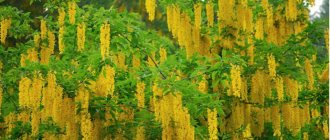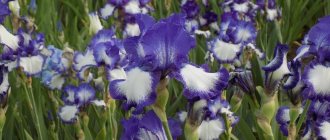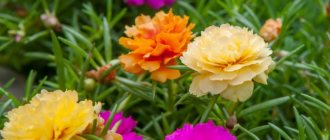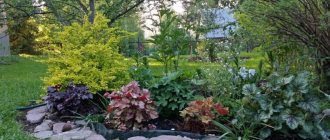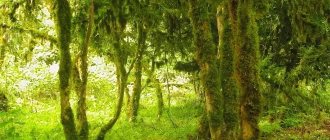Boxwood is a long-lived ornamental plant, a valuable type of wood, and a natural antiseptic. At the same time, all vegetative parts are poisonous - you should know how to handle it. The diversity of the genus allows it to be grown in open ground and at home. Boxwood's hardiness, proper planting and simple care help ensure successful growth even in central Russia.
In the dictionaries of the living Russian language it is called: bux, buxus, greenery or iron tree, geva, bukshpan.
Description of the boxwood genus
Buxus (boxwood) - low-growing shrubs or trees that grow up to 2-10 m, are considered evergreen, slow-growing plants. Over the course of a year, depending on the species, the crown increases by only 5-7 cm, and the diameter of the trunk increases by 1 mm. Buxus belongs to a small group of long-livers in the plant world. Scientists suggest that the boxwood genus is more than 30 million years old. In the jungle there are 600-year-old specimens. There are known descriptions of the axle box in ancient treatises of the 6th century; it still has the same appearance and properties. Botanical structure of the plant:
- The root system is branched. The main root is shortened. Powerful lateral shoots and many suction roots extend from it, firmly holding the plant in the soil.
- The branches are tetrahedral, elastic, strong and grow sideways and upward in bush types of boxwood, clinging to the trunk, while in trees they are spreading. They form a dense compact crown.
- The bark is thin, hard, yellowish-gray on young specimens, fissured brown on adult specimens.
- Leaves, depending on the type: small, round or elongated with a solid edge, leathery, glossy, dark green. Located oppositely, they form a thick, beautiful crown.
- The flowers are unisexual, small, without perianth, yellowish with a honey aroma, located in the leaf axils. Boxwood blooms from 15 to 20 years: warm climate - March-April, middle zone - May.
- The fruit is a capsule with 3 nests. When ripe, it cracks and shoots seeds far away.
- The seeds are black, shiny, large.
It is worth warning beekeepers that honey cannot be used after bees have collected poisonous nectar, and it is dangerous for the insects themselves.
Boxwood wood is hard and dense. It sinks in water and cannot be cut with an axe.
All parts of boxwood, especially the leaves and bark, contain a huge amount of alkaloids. Among which:
- cyclobuxin D, lethal dose for a dog is 0.1 mg per kg of weight;
- vincristine, has antitumor properties;
- caffeine has a psychostimulant effect;
- cocaine is psychotropic.
And also buxin - the main toxic substance, parabuxin, buxipin, which served as the second name of the plant. There are about 70 elements in total, an overdose of which poisons a person.
There are also valuable properties of the shrub: even non-flowering buxus exudes a pungent odor due to the essential oils in its composition that are active against microbes. Released in huge quantities, volatile phytoncides disinfect the air around the plant.
Diseases
The most dangerous disease for him is necrosis caused by a fungus. It manifests itself as spots on the leaves and the death of the upper parts of the plant. It is treated with fungicides, which are used several times intermittently.
The most dangerous thing for boxwood is cancer, in which it is necessary to cut off the infected parts and at the same time partially capture the healthy wood. Sections must be treated with Fundazol.
Types and varieties of boxwood
The genus Buxus of the Boxwood family is diverse, represented by 104 species. They all differ in height, growth rate, color and crown shape. Only a few varieties are used in landscape gardening. Thanks to selection, new decorative forms resistant to the vagaries of nature appear.
Balearic boxwood
Buxus Balearicus bears the name of its place of growth. The largest species of the genus. In the natural habitat of the Balearic Islands of Spain, Morocco - a tall tree, reaching 20 m in height, or a tall, wide bush with a pyramidal crown. A tender and heat-loving plant. Able to survive and fully develop only in the mild maritime climate of southern latitudes or in humid room conditions. Although it can withstand short-term frosts down to – 18 °C. Artificially bred in Crimea and the Caucasus since 1817.
It differs from its relatives in its large shapes and elliptical leaves up to 5 cm long and 2.5 cm wide, and relatively fast growth.
Evergreen boxwood
Boxwood (Buxus sempervirens), also called common boxwood, is a slow-growing evergreen tree or shrub. In nature it reaches 10 m in height, in culture 1.5-3 m. Frost-resistant species. It winters under snow cover even in central Russia. This property allows breeders to create specimens for northern regions.
Prefers calcareous soils and dry climates. Unpretentious to planting, requires minimal care. Withstands haircuts very well. Slow growth and long-term preservation of shape are used to create living walls and hedges, topiary gardens.
Popular varieties of evergreen boxwood:
- Buxus sempervirens Aurea. A compact shrub up to 1 m tall, distinguished by green-yellow leaves and uniform yellow growths. Prefers neutral calcareous soils fertilized with humus. Requires shelter for the winter;
- Buxus sempervirens Blauer Heinz. A spherical, low-growing bush with greenish-blue oblong leaves. Drought resistant. Unpretentious to soil composition and planting location;
- Buxus sempervirens Elegans. An evergreen spherical bush up to 100 cm tall with shiny variegated leaves edged with a white stripe.
It is unpretentious to care and location: it grows in the sun and in the shade, is undemanding to watering, and tolerates severe frosts under cover.
In home floriculture, evergreen boxwood is the most common. In indoor conditions, common buxus disinfects the air, but is still dangerous for children and animals.
Colchis boxwood
Buxus colchica or Caucasian boxwood is similar in appearance to the evergreen species. It grows into a tall tree with an oval crown and a smooth trunk, reaching a diameter of 50 cm. It is widespread in the shady forests of the foothills of the Caucasus, Asia Minor, and is found in the Sochi regions.
Unusually shade-tolerant and frost-resistant. Winters well under shelter and snow cover in the northern regions of Russia, blooms and bears fruit. Unpretentious to soil composition. It grows on pebbles, sandstones, clay and loams, on rocks, adapting the root system to the ground.
Small-leaved boxwood (Buxus microphylla)
This type of axle box comes from Japan. It is distinguished by its compact forms: a low shrub 100-120 cm. With the smallest rounded leaves up to 2 cm long and 1.5 cm wide.
It can withstand frosts of 30 °C, but is afraid of direct spring sun and requires shelter. Cultivated since 1860. Used in the landscape as borders and low hedges.
Varieties:
- Buxus microphylla Faulkner. Slow growing 1.5 m bush with small leaves. An increase of about 5 cm per year gives a natural spherical shape. Requires regular watering, fertile soil, but is very shade-tolerant.
- Buxus microphylla var. Koreana.
- Buxus microphylla Golden Triumph.
All varieties of boxwood grown in the middle zone can withstand frosts only to the depth of snow cover. They are also afraid of the burning rays of the spring sun, so it is better to cover them with special material for the winter. They withstand crown pruning very well.
Small-leaved boxwood is also grown at home in the form of a bonsai. As a potted option, boxwood is suitable for decorating verandas, terraces and other indoor and outdoor areas.
The variety of types of boxwood allows you to select options for any purpose: create bright exotic accents, compositions or an entire garden.
Growing from seeds
Prepare warm water in which to dissolve the growth stimulator - Epin or Zircon. Fresh but mature seeds are immersed there for 1 day.
After this, they are placed between 2 damp (not wet!) towels for about 28 days or until white shoots appear. They should be checked and moistened from time to time.
If after 2-3 weeks there is no sign that they are about to germinate, put them in the refrigerator in the crisper drawer. Then place it again in a warm place.
Sprouted seeds are sown in pots into which a special substrate is poured (peat and sand in equal proportions). A film is placed on top and placed in warmth and partial shade.
In a couple of weeks the first shoots will appear. Then you should water them regularly and feed them with a light fertilizer solution until they get stronger. Planting outside is possible only after the threat of frost has passed.
Boxwood distribution
Representatives of the heat-loving, shade-tolerant genus of axelwood in their natural habitat grow on slightly acidic soils of rocky screes, in shady oak forests, impenetrable thickets of bushes, and on the edges of deciduous forests.
They are found in the jungles of Southern Equatorial Africa and the island of Madagascar. In the tropics and subtropics of Central America, the tallest 20 m relict trees with large foliage grow. The South Asian range extends from the British Isles to Japan, through southern Europe, Asia and China.
For centuries, boxwood forests have been cut down due to the value of the wood. In Russia, there are only a few unique areas left in the Adygei Nature Reserve.
On the Black Sea coast, where the only species of Colchian boxwood grows, now listed in the Red Book. There are boxwood groves in Sochi (Matsesta microdistrict) and Abkhazia in the city of Pitsunda.
Planting boxwood
Bux grows well in shady corners of the garden, where other bushes wither. It is not afraid of the hot summer rays of the sun, so the location does not affect the survival rate of the seedling. Gardeners advise choosing boxwood for planting in a container from a nursery in your region or growing it yourself from cuttings.
Recommendations for soil
Cultivated boxwood grows in one place for more than 60 years, so the soil for planting is carefully prepared. Books prefers:
- loose;
- breathable;
- nutritious;
- neutral or slightly acidic soil.
In alkaline or acidic conditions it gives weak crown growth. Boxwood grows ideally on moderately moist loams. Dolomite flour and compost are added to sandstones. Does not tolerate wetlands. Requires drainage.
Boxwood planting dates
It takes at least a month for the bush to take root. Young boxwood seedlings are planted in open ground in the spring to branch out and strengthen the root system. Adult, already flowering, axle-boxes are planted in early autumn, 1-1.5 months before the expected frost, giving the plants the opportunity to take root and adapt before wintering. Next spring the boxwood will bloom in a new place.
Seedlings with closed roots and domestic specimens are planted during any period of active sap flow from April to September.
Planting stages
Before planting, the container seedling is placed in water for a day so that the soil is well saturated with water. Planting boxwood occurs in several stages:
- A hole is dug that is 3 times larger in depth and width than the root system or earthen ball of the container specimen.
- The soil is mixed with humus, perlite or expanded clay to increase air and moisture exchange.
- The bottom of the pit is covered with drainage, protecting the roots from flooding;
- The hole is half filled with nutritious soil.
- The straightened roots are covered with prepared soil and compacted with water.
Planting the axle box is completed by moistening the soil and mulching.
For a hedge 1 m long, at least 8 boxwood sprouts are planted in a line. To get a dense fence you will need 15-30 pieces. They are distributed in 2-3 rows every 15-20 cm in a checkerboard pattern.
Axle transplant
Hardy boxwood in the garden grows well in one place all its life; it is enough to only occasionally replace the top layer of soil and organize proper care. If for some reason boxwood needs to be replanted, it is done within the recommended time frame, but with the onset of stable heat in spring, autumn - 45 days before frost.
At home, change the soil for plants every 3-4 years. Use special soil for boxwoods or a mixture of 4 parts turf soil, 2 leaf soil, 1 coarse river sand, perlite.
Features of garden care
How to grow boxwood
Growing boxwood is very simple, especially if you are familiar with the basic rules of its cultivation. If after the plant is planted it does not rain for a week, then it needs to be watered. When watering, it is worth considering that a meter-high bush should require 10 liters of water. Water should be poured carefully at the root to the surface; it should be taken into account that if there is a dry period outside or dry and rather hot winds are blowing, then there is no need to increase the frequency of watering, but more water should be poured. When watering is completed, it is imperative to loosen the surface of the soil and carry out weeding at the same time. In the first days of May, after the soil has warmed up thoroughly, you need to sprinkle its surface with a layer of mulch (peat), the thickness of which varies from 5 to 8 centimeters. It should be taken into account that peat should not touch young shoots or the trunk of the plant.
Boxwood needs to be fed systematically. The first feeding should be done only 4 weeks after the seedling is planted. But this is only if planting was done in the spring, since fertilizers can be added to the soil only after the seedling has completely rooted. During intensive growth, the plant needs organic or complex mineral fertilizer, and in the autumn, while digging, potassium or phosphorus fertilizers are added to the soil, because boxwood does not need nitrogen at this time.
Transfer
It is recommended to replant such a plant in spring. The fact is that over the summer and autumn it will have time to take root well and will safely survive the winter. Transplantation of adult specimens should be carried out together with a clod of earth. The transplantation rules are identical to those used when planting seedlings in open ground. If you follow these rules, the plant will quickly and easily take root in a new location.
Trimming
Pruning should be done in April or in the first days of May. Often, when pruning, boxwood bushes are shaped into a cone, cube or ball. Boxwood can also be cultivated as a standard tree. To do this, it is necessary to cut all the stems, except the strongest, to the very root. Those young stems that grow at the top of the central standard stem are pruned, usually giving them the shape of a ball. It should be remembered that once you have formed a bush, you will only need to correct its shape from time to time, and all because boxwood is a slow-growing plant. In this case, as a rule, only growing young stems need to be trimmed, and old ones may need adjustment only if the shape of the bush is completely lost. Pruning does not cause any harm to the bush, and the more often you trim, the thicker it will become. Experts advise trimming boxwood regularly once a month. But it should be taken into account that the more frequent the pruning, the more often you need to water and fertilize. The fact is that the bush needs to restore its strength, replenish those nutrients that were lost along with the cut leaf plates.
Boxwood pruning
Diseases and pests
The most dangerous pest for this plant is the boxwood gall midge. In the first days of summer, she lays her eggs in those young leaf plates that are located on the tops of the stems. The emerging larvae eat into the leaf tissue and remain there for the winter. And already in May, adult individuals emerge from the formed pupae. If there are a lot of these pests on a plant, then it begins to dry out and die. You can get rid of this harmful insect with the help of Karbofos, Tagore, Aktar, Fufanon. 1.5 weeks after treatment, inspect the boxwood; if there is no significant improvement, then treat it a second time. These insecticidal agents will help get rid of felt weeds. You can recognize an infection with it by swellings on the leaf blades, and the shoots begin to fade. These remedies will also help get rid of spider mites, which can appear during a long drought.
This plant can become infected with shoot necrosis, in which spots appear on the leaf blades and the tops of the branches begin to die. In order to get rid of such a disease, fungicidal agents will be needed, and, as a rule, several treatments are carried out intermittently. The most dangerous thing for this plant is cancer. You need to cut off the affected parts of an infected bush, but be sure to grab healthy wood as well. After this, the sections should be treated with Fundazol.
In Moscow and Moscow region
Boxwood should be planted in Moscow and the Moscow region, and cared for in exactly the same way as in other areas with a temperate climate. But it is worth considering that if the winter period is quite frosty, then the plant must be prepared for wintering.
Boxwood care
The undemanding shrub does not require special care. To increase the lifespan and decorativeness of a plant, it is worth learning important points:
- Watering is rare, but plentiful in the dry, hot season, with a deep flow of soil of 10 l/m2. Boxwood is drought-resistant and does not tolerate stagnation of water.
- Regular feeding begins in the first years of life. It is recommended to use an organomineral complex in spring and summer after flowering. In the fall, you should not fertilize boxwood so that the bush prepares for the dormant period. Domestic axles receive their last feeding in August.
- Mulching protects against drought and weeds, retains heat and water exchange of roots in the spring and winter, organic material provides additional nutrition. It is important not to cover the trunk with mulch - it will rot. They use: peat, sawdust and crushed conifer bark, crushed limestone and similar materials.
- Trimming. Box grows slowly and tolerates pruning well. It is cut when the growth disrupts the decorative effect. To form a crown, shoots are pruned at any time during the growing season. A radical anti-aging haircut is performed on adult shapeless bushes, while a curly haircut is done using templates.
- Preparing for winter. Growing buxus in a harsh climate requires additional measures: deep, abundant watering in dry autumn so that the roots are filled with moisture and do not freeze during the snowless period; winter shelter with agrofibre, protecting from severe frosts and the burning winter-spring sun.
Preparing boxwood for winter is a troublesome task, but the result will delight you in the spring with the healthy appearance and lush color of the leaves of the evergreen, heat-loving southerner.
Watering
As you can see, caring for boxwood does not require any special knowledge or skills.
If it’s summer, the weather is hot, and rain has not been seen for a long time and is not expected, then your boxwood should be watered once a week. For one meter-long boxwood you will need about ten liters of clean water.
If the weather is dry, you should not water more frequently. It will be enough to increase the number of liters of water. Next, it is recommended to loosen the soil and also remove all weeds that may grow near the boxwood.
With the onset of May, the area where boxwood grows is covered with peat mulch. An important rule is that the peat and the tree stem should not touch each other.
Important recommendation: when choosing a place where you will plant boxwood, remember that it does not tolerate excessive moisture. The place where it will grow should not collect moisture. The plant doesn't like it.
If your soil is quite poor, with a high sand content, you can enrich it with the addition of mature compost and slaked lime.
Living fence - the best ideas on what to make a hedge from at your summer cottage. Many photos of ready-made options with exclusive designs + instructions- Trimming bushes - the basics of choosing the right plants and forming the right shapes, selecting tools (photo + video)
Landscaping a site - basic principles and rules for creating a beautiful site with your own hands
Boxwood propagation
In the regions of central Russia, buxus is considered exotic. Seedlings are expensive, and creating hedges and large group plantings requires a lot of them. Gardeners try to propagate the plant on their own, especially since boxwood reproduces beautifully from cuttings all year round.
Cuttings are taken from young, not yet lignified shoots. The soil for growing needs loose, well-drained soil. Cut branches 10-15 cm in size are kept in a growth stimulator for a day, then planted in a container or on a bed with prepared soil.
If you tear off a branch with a heel, you get more area for the formation of roots.
A favorable microclimate is created for the seedlings by covering them with transparent containers. Keep the soil moist. It is important not to water the cuttings, but to moisten them with a spray bottle so as not to swamp the soil. The greenhouses are regularly ventilated. Rooting occurs in 2-3 months. For the winter, sprouts in open ground are insulated with burlap. In room conditions, remove the cover.
Experienced gardeners recommend transplanting seedlings grown from boxwood cuttings to a permanent place in the open ground after 3 years.
How to transplant
The boxwood plant is best replanted in the spring. During the warm period, he manages to take root in a new place and thanks to this it will not be difficult for him to endure the winter months.
An adult plant is transplanted along with a lump of earth. In general, it is enough to adhere to the general rules of replanting so that the bush successfully endures a change in its location.
Diseases and pests
The biological feature that helps Buxu protect itself from pests and diseases is the pungent odor and bactericidal properties of the released essential oil. In the last 20 years, two worst enemies of boxwood have appeared in Russia, which it cannot cope with without human help:
- boxwood moth;
- fungus Cylindrocladium buxicola.
Parasites were imported with planting material from foreign nurseries.
Signs of fungal disease:
- light or dark brown spots;
- white coating;
- leaves and shoots turn yellow.
Boxwood dries quickly. High humidity and temperature aggravate the disease. The affected plant is attacked by other fungi and insects. In this case, even leaves cannot be removed without spraying. Fungal spores are volatile.
How to treat boxwood against fungi:
- Eminent - 3 sprays per season.
- Topsin M – May, September.
- Signum and Bumper Super - alternate after 8 days at the first sign.
After the 1st spraying, cut off the affected leaves and burn the branches. Prevention with fungicides will protect against unexpected diseases.
If caterpillars and moths appear, use the specialized drug BI-58. For other parasitic insects - mites, thrips, boxwood gall midges - they are sprayed, alternating with different acaricides.
Combination with other plants
Boxwood and heuchera
The calm and deep color of boxwood combines effectively with heuchera in the flowerbed. The latter is planted as a frame for bright leaves. Such a successful contrast will significantly diversify the landscaping. Boxwood is an excellent neighbor from the agricultural side; it will help get rid of pests, soil corrosion, and protect from drafts, dust and wind.
You can create a focal point on the lawn by combining boxwood with bright flowering shrubs: lilac, jasmine, thunberg barberry, bush rose, cistus. For an original culture contrast, bright colors are selected (yellow, pink, red, white). The standard form of the “iron tree” will be an excellent backdrop for flowering crops. This will smooth out the variegation and pretentiousness, giving the composition restraint and aristocracy.
Near a pond, boxwood will be a good “company” for lilies, calamus and marigolds. When deciduous plants fade, the “iron tree” will prevent the coastal area from looking deserted and dull.
The meaning and use of boxwood
The relict shrub or buxus tree is valued for its decorative properties of young plants, high strength of wood, and medicinal properties. Also characteristic of boxwood is the ability to painlessly tolerate pruning of shoots; it is valued in landscaping gardens and parks: unique shapes and compositions are created.
The rare density, strength of ironwood wood, amber coloring, smooth surface have been used since ancient times by craftsmen for making art objects (wood engravings, inlays), musical instruments, small unique items: netsuke, gaming figurines, measuring and optical instruments, surgical instruments and many other unusual details.
Since ancient times, the poisonous properties of boxwood have been used by healers both for treatment and in other capacities. Modern pharmacology does not use axle preparations due to the impossibility of precise dosing.
Use in landscape design
Boxwood is a godsend for landscapers and phytodesigners; it is incomparable in topiary art. The slow growth and density of the crown retains the shape and decorativeness of the figure for a long time. The variety of types of buxus allows you to create real sculptures from border strips to giant walls, fancy characters, solitaires and compositions.
The important properties of boxwood - durable and evergreen - will give a long life to embodied creative ideas and fantasies. They will not fly around and turn into bare skeletons made of twigs, but will impress for many years.
Boxwood figures combine or contrast with many ornamental plants and herbs, creating harmonious ensembles. With large conifers or creeping species, boxwood bushes look original. The shade tolerance of boxwood allows you to play up and add charm to the most unsightly corners of the garden.
Boxwood is an amazing plant. Having overcome centuries-old “urbanization”, it has retained its beauty and endurance unchanged. Having surrounded him with care and attention, he will serve humanity for a long time, bringing beautiful, kind, eternal things.
We propagate using layering
This method has proven itself over time. It is effective and quite simple. In the spring you will need to bend several lower branches to the ground and dig them in.
Now you have learned how to grow evergreen home boxwood yourself and without much effort. You just need to follow the recommendations given for the plant to delight you with its beauty.In the warm season, they constantly need to be fertilized and not to forget about watering. After they begin to grow, you can separate them from the parent and, if necessary, replant them.
